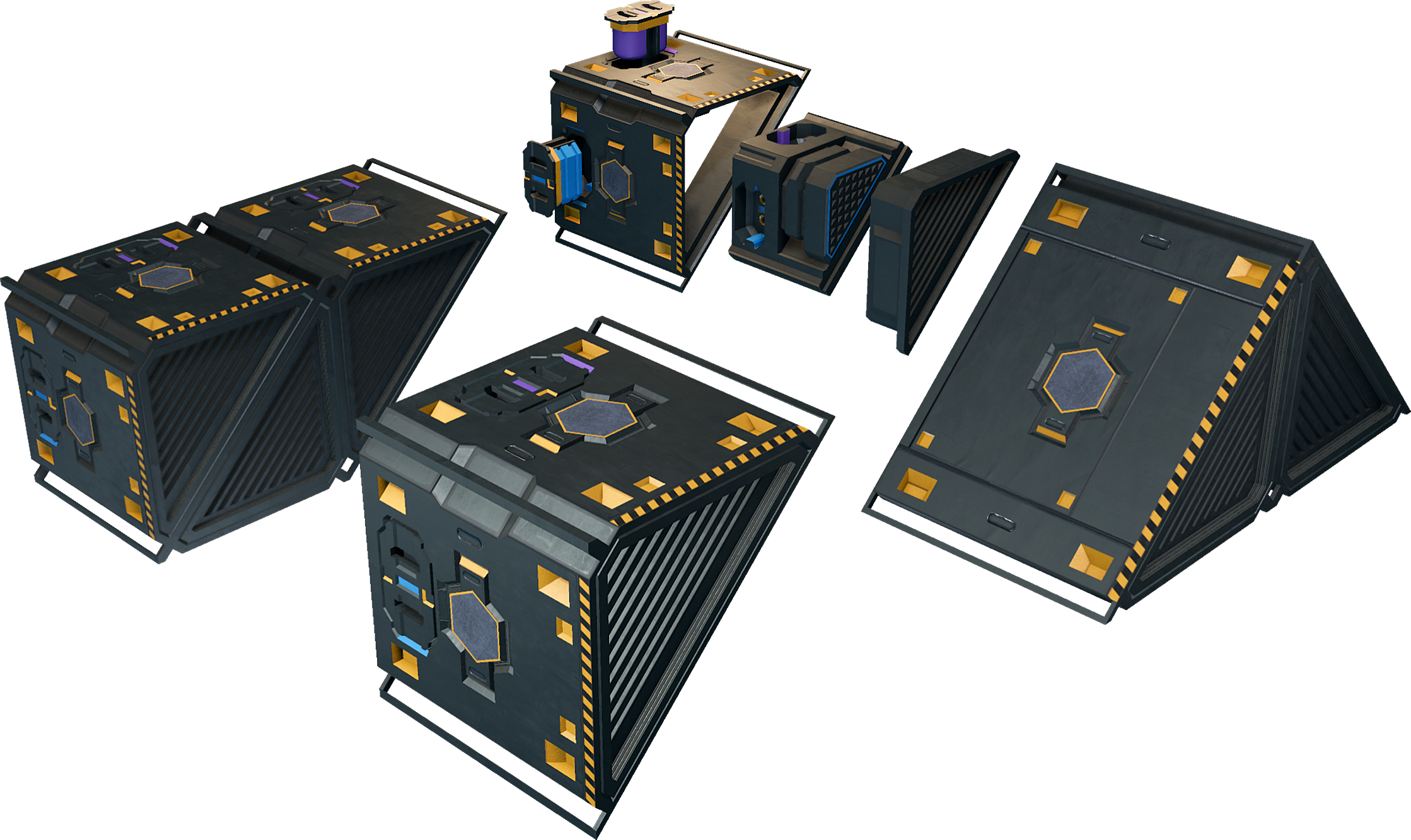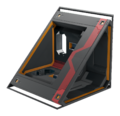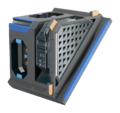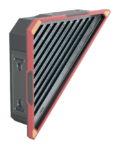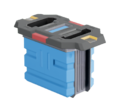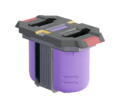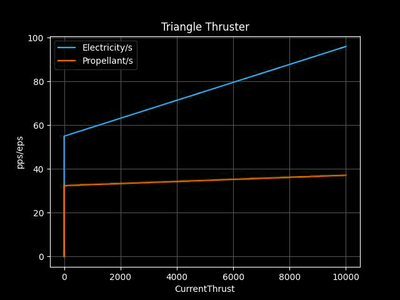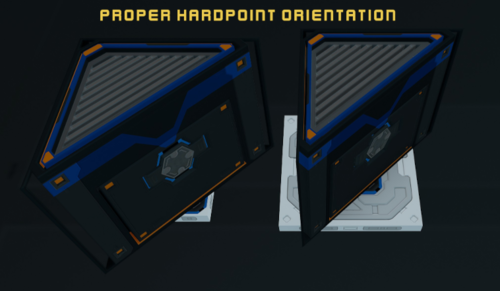Difference between revisions of "Triangle thruster"
m |
|||
| (31 intermediate revisions by 7 users not shown) | |||
| Line 1: | Line 1: | ||
{{Otherlang2 | {{Otherlang2 | ||
|jp=トライアングルスラスター | |||
}}{{SB Infobox Begin | }}{{SB Infobox Begin | ||
|{{SB Infobox Header | |{{SB Infobox Header | ||
|image=[[Image:Starbase_Triangle_thruster_stacks.png]] | |image=[[Image:Starbase_Triangle_thruster_stacks.png]] | ||
|previewImage=[[Image:Triangle thruster stacks preview.png]] | |||
|factionLogo= | |factionLogo= | ||
|caption= | |caption= | ||
| Line 12: | Line 14: | ||
|type=Thrusters | |type=Thrusters | ||
|function=Generates propulsion | |function=Generates propulsion | ||
|size=144×144×144 cm | |size=144×144×144 cm | ||
|mass=11,512.05 | |mass=11,512.05 ''(approx.)'' | ||
|volume=1,156.99 | |volume=1,156.99 | ||
|corrosionResistance=350 | |corrosionResistance=350 | ||
|suppressUnitsKg | |suppressUnitsKg=1 | ||
|suppressUnitsKv | |suppressUnitsKv | ||
}} | }} | ||
|{{SB Infobox Device IO | |{{SB Infobox Device IO | ||
|electricIn=96 e/s | |electricIn=<ul><li>96.2 e/s ''(all T1)''</li> | ||
<li>84.1 e/s ''(all T2)''</li> | |||
<li>136.1 e/s ''(all T3)''</li></ul> | |||
|electricOut= | |electricOut= | ||
|coolantIn= | |coolantIn= | ||
|coolantOut= | |coolantOut= | ||
|propellantIn= | |propellantIn=<ul><li>27.864 p/s ''(all T1)''</li> | ||
<li>24.369 p/s ''(all T2)''</li> | |||
<li>35.239 p/s ''(all T3)''</li></ul> | |||
|propellantOut= | |propellantOut= | ||
|fuelIn= | |fuelIn= | ||
|fuelOut= | |fuelOut= | ||
|thrust=300,000 | |thrust=<ul><li>300,000 ''(all T1)''</li> | ||
<li>330,000 ''(all T2)''</li> | |||
<li>390,000 ''(all T3)''</li></ul> | |||
|sockets= | |sockets= | ||
|YOLOLchips= | |YOLOLchips= | ||
| Line 36: | Line 44: | ||
|deviceInterfaces=1 | |deviceInterfaces=1 | ||
}} | }} | ||
|{{SB Infobox Component Section | |||
|{{SB Infobox | |Triangle thruster body | ||
| | |Triangle thruster combustion chamber | ||
| | |Triangle thruster nozzle | ||
| | |Thruster electricity converter | ||
| | |Thruster gas converter | ||
| | |||
}} | }} | ||
}}<section begin=summary/>Triangle thrusters are a type of [[Thrusters|thruster]] while smaller and less powerful than [[Box Thrusters|Box Thruster]], allow for modular construction of compound thrusters. Triangle thrusters that touch on any of the three sides (excluding the nozzle or [[Hardpoint|hardpoint]]) share a single group and device [[Hardpoint|hardpoint]]. This means that Triangle Thrusters can be stacked to farm large single thrusters, however this comes at the cost of finite control as single thrusters within the group become [[YOLOL|inaddressable]]. '''Important: Renaming connected triangle thrusters into separate groups will not make them fire individually! Instead it will cause significant scripting issues.'''<section end=summary/> | |||
}}<section begin=summary/>Triangle thrusters are a type of [[Thrusters|thruster]] | |||
== Basic information == | == Basic information == | ||
| Line 78: | Line 58: | ||
Triangle thrusters are composed of five distinct components: | Triangle thrusters are composed of five distinct components: | ||
* The body, which houses the other components and provides convenient mounting surfaces. The body also holds two of the modular ports. | * The body, which houses the other components and provides convenient mounting surfaces. The body also holds two of the modular ports. | ||
* The chamber, which burns [[Propellant|propellant]] to produce thrust. The chamber holds the final modular port. | * The chamber, which burns [[Propellant tank|propellant]] to produce thrust. The chamber holds the final modular port. | ||
* The nozzle, which channels the exhaust out of the chamber (thus producing thrust). | * The nozzle, which channels the exhaust out of the chamber (thus producing thrust). Any tier of nozzle is compatible with any tier of body. | ||
* The electricity converter, which converts power from [[Generator|generators]] and [[Battery|batteries]] into power usable by the thruster. | * The electricity converter, which converts power from [[Generator (Assembly)|generators]] and [[Battery|batteries]] into power usable by the thruster. Any tier of electricity converter is compatible with any tier of body. | ||
* The | * The propellant converter, which prepares propellant to be burnt. Any tier of propellant converter is compatible with any tier of body. | ||
Despite their relatively low thrust power per unit, the modularity and ease-of-use that triangle thrusters offer is unmatched, though one does need to be careful to properly protect grouped thrusters as the destruction of just a few units can cause a total disruption of the entire thruster bank. 2 triangle thrusters exceeds the amount of thrust from a single box thruster while saving on space, so they are common on cheap short range shuttles or as part of the main thrust on massive freighters where propellant is not a concern. | |||
== Device fields == | |||
===[[Triangle_thruster_body|Triangle thruster body]]=== | |||
{{#lst:Triangle_thruster_body|deviceFields}} | |||
To learn more about how to use fields, consult these wiki pages: | |||
* [[Universal tool|Universal Tool]] | |||
* [[Data networks|Data networks]] | |||
* [[YOLOL|YOLOL]] | |||
== Related content == | |||
[[File:Triangle_thruster_resource_usage_(dark).png|400px]] | |||
[[File:Triangle_Thruster_Orientation.png|500px]] | |||
[[Category:Devices and machines]] | [[Category:Devices and machines]] | ||
Latest revision as of 23:40, 10 July 2023
- 96.2 e/s (all T1)
- 84.1 e/s (all T2)
- 136.1 e/s (all T3)
- 27.864 p/s (all T1)
- 24.369 p/s (all T2)
- 35.239 p/s (all T3)
- 300,000 (all T1)
- 330,000 (all T2)
- 390,000 (all T3)
Triangle thrusters are a type of thruster while smaller and less powerful than Box Thruster, allow for modular construction of compound thrusters. Triangle thrusters that touch on any of the three sides (excluding the nozzle or hardpoint) share a single group and device hardpoint. This means that Triangle Thrusters can be stacked to farm large single thrusters, however this comes at the cost of finite control as single thrusters within the group become inaddressable. Important: Renaming connected triangle thrusters into separate groups will not make them fire individually! Instead it will cause significant scripting issues.
Basic information
Triangle thrusters are composed of five distinct components:
- The body, which houses the other components and provides convenient mounting surfaces. The body also holds two of the modular ports.
- The chamber, which burns propellant to produce thrust. The chamber holds the final modular port.
- The nozzle, which channels the exhaust out of the chamber (thus producing thrust). Any tier of nozzle is compatible with any tier of body.
- The electricity converter, which converts power from generators and batteries into power usable by the thruster. Any tier of electricity converter is compatible with any tier of body.
- The propellant converter, which prepares propellant to be burnt. Any tier of propellant converter is compatible with any tier of body.
Despite their relatively low thrust power per unit, the modularity and ease-of-use that triangle thrusters offer is unmatched, though one does need to be careful to properly protect grouped thrusters as the destruction of just a few units can cause a total disruption of the entire thruster bank. 2 triangle thrusters exceeds the amount of thrust from a single box thruster while saving on space, so they are common on cheap short range shuttles or as part of the main thrust on massive freighters where propellant is not a concern.
Device fields
Triangle thruster body
| YOLOL field | description | range |
|---|---|---|
| ThrusterState | Requested output of the thruster | 0 - 10 000 |
| ThrusterCurrentThrust | Current output of the thruster | 0 - 10 000 |
To learn more about how to use fields, consult these wiki pages:
